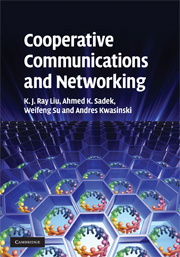Book contents
- Frontmatter
- Contents
- Preface
- Part I Background and MIMO systems
- Part II Cooperative communications
- 4 Relay channels and protocols
- 5 Cooperative communications with single relay
- 6 Multi-node cooperative communications
- 7 Distributed space–time and space–frequency coding
- 8 Relay selection: when to cooperate and with whom
- 9 Differential modulation for cooperative communications
- 10 Energy efficiency in cooperative sensor networks
- Part III Cooperative networking
- References
- Index
6 - Multi-node cooperative communications
from Part II - Cooperative communications
Published online by Cambridge University Press: 06 July 2010
- Frontmatter
- Contents
- Preface
- Part I Background and MIMO systems
- Part II Cooperative communications
- 4 Relay channels and protocols
- 5 Cooperative communications with single relay
- 6 Multi-node cooperative communications
- 7 Distributed space–time and space–frequency coding
- 8 Relay selection: when to cooperate and with whom
- 9 Differential modulation for cooperative communications
- 10 Energy efficiency in cooperative sensor networks
- Part III Cooperative networking
- References
- Index
Summary
In the previous chapter, the symbol error rate performance of single-relay cooperative communications was analyzed for both the decode-and-forward and amplify-and-forward relaying strategies. This chapter builds upon the results in the previous chapter and generalizes the symbol error rate performance analysis to the multi-relay scenario.
Decode-and-forward relaying will be considered first, followed by the amplify-and-forward case. In both scenarios, exact and approximate expressions for the symbol error rate will be derived. The symbol error rate expressions are then used to characterize an optimal power allocation strategy among the relays and the source node.
Multi-node decode-and-forward protocol
We begin by presenting a class of cooperative decode-and-forward protocols for arbitrary N-relay wireless networks, in which each relay can combine the signal received from the source along with one or more of the signals transmitted by previous relays. Then, we focus on the performance of a general cooperation scenario and present an exact symbol error rate (SER) expressions for both M-ary phase shift keying (PSK) and quadrature amplitude modulation (QAM) signalling. We also consider an approximate expression for the SER of a general cooperation scenario that is shown to be tight at high enough SNR. Finally, we study optimal power allocation for the class of cooperative diversity schemes, where the optimality is determined in terms of minimizing the SER of the system.
- Type
- Chapter
- Information
- Cooperative Communications and Networking , pp. 194 - 237Publisher: Cambridge University PressPrint publication year: 2008
- 1
- Cited by



